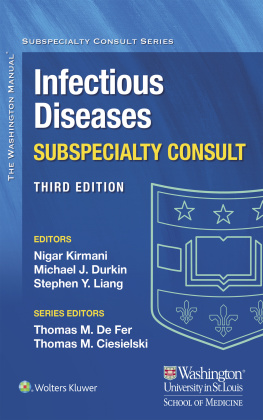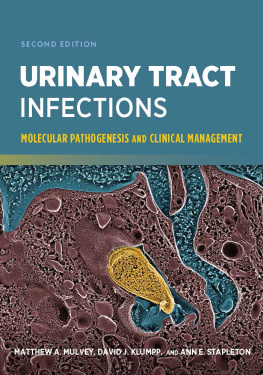An Unnatural History of Emerging Infections
An Unnatural History of Emerging Infections
RON BARRETT AND GEORGE J. ARMELAGOS

An Unnatural History of Emerging Infections. First Edition. Ron Barrett and George J. Armelagos Ron Barrett and George J. Armelagos 2013. Published 2013 by Oxford University Press.

Great Clarendon Street, Oxford, ox2 6DP,
United Kingdom
Oxford University Press is a department of the University of Oxford. It furthers the Universitys objective of excellence in research, scholarship, and education by publishing worldwide. Oxford is a registered trade mark of Oxford University Press in the UK and in certain other countries
Ron Barrett and George J. Armelagos 2013
The moral rights of the authors have been asserted
First Edition published in 2013
Impression: 1
All rights reserved. No part of this publication may be reproduced, stored in a retrieval system, or transmitted, in any form or by any means, without the prior permission in writing of Oxford University Press, or as expressly permitted by law, by licence or under terms agreed with the appropriate reprographics rights organization. Enquiries concerning reproduction outside the scope of the above should be sent to the Rights Department, Oxford University Press, at the address above
You must not circulate this work in any other form
and you must impose this same condition on any acquirer
Published in the United States of America by Oxford University Press
198 Madison Avenue, New York, NY 10016, United States of America
British Library Cataloguing in Publication Data
Data available
Library of Congress Control Number: 2013936271
ISBN 9780199608294
Printed and bound by
CPI Group (UK) Ltd, Croydon, CR0 4YY
Links to third party websites are provided by Oxford in good faith and
for information only. Oxford disclaims any responsibility for the materials
contained in any third party website referenced in this work.
George: To Jack and Mary Kelso
Ron: To the ancestors, the Panchdevi, and Mike the Chimpanzee
Acknowledgements
This book is a culmination of many years of work with many people. In particular, we would like to thank Chris Kuzawa and Thom McDade, who were our co-authors on the seminal article for this book. Credit also goes to James Lin for independently noting that the current emerging disease trends represent a Third Epidemiological Transition. Thanks to Kristin Harper, who contributed to our later thinking about these transitions. Thanks to all the students in our emerging infections courses for their many questions and insights. Thanks as well to Dennis Van Gerven, Alan Swedlund, Richard Meindl, Merrill Singer, Peter Brown, Steve Hackenberger, Joe Lorenz, Ian Buvit, Brad Belbas, Erik Davis, David Woolsey, Gabe Sibley, and John and Audrey Eyler. Special thanks to Scott Legge, Christy Hansen, and Steve Sundby for their thoughts and comments on earlier drafts. Thanks to Clark Larson, Dennis VanGerven, Dan Bailey, and Gwen Robbins Schug for permitting us to use their images in this book. Special thanks to Justin Gibbens for his brilliantly provocative cover art. Ron would like to thank his colleagues at Macalester Anthropology: Dianna Dean, Margo Dickinson, Olga Gonzalez, Arjun Guneratne, Scott Legge, Sonia Patton, and Dianna Shandy, as well as his family, Ron Sr., Dianne, Tara, Maya, Tiffany, Avena, Nic, and Taiya. And a very special thanks to Lene Pedersen, Rons colleague, partner, and writing coach, who carefully read and edited every draft of this book. And finally, we would like to thank our editors and supporters at Oxford University Press: Ian Sherman, Helen Eaton, Lucy Nash, Muhammad Ridwaan, and G. Hari Kumar for shepherding this project to completion.
Contents
We ask the God of Plague: Where are you bound?
Paper barges aflame and candlelight illuminate the sky.
Farewell to the God of Plague. Mao Zedong (1958)
Microbes are the ultimate critics of modernity. Despite our reigning civilizations, it is the microbes, not the humans, who are the colonial masters of the living world.
Outnumbered and outgunned, we should not be surprised at our inability to control pathogens, the particular subset of microbes that contribute to infectious disease. Yet for many years, this unfortunate reality did not prevent authorities from making optimistic pronouncements about the imminent demise of human infections. Sir Macfarlane Burnet, the pioneering Australian virologist and Nobel laureate, famously described the middle of the 20th century as the end of one of the most important social revolutions in history, the virtual elimination of the infectious diseases as a significant factor in social life (Burnet 1962: iii). As president of the American Association of Medical Colleges, Robert Petersdorf predicted that there would be scant role for infectious disease specialists in the next century, unless, as he wrote, they would spend their time culturing one another (Petersdorf 1986: 478). Such statements reflected a clinical consensus that most major human infections would be eradicated by the beginning of the 21st century, and that attention and resources would be focused on eliminating the so-called chronic diseases of civilization such as cancer, diabetes, and heart disease. Many health policies shifted accordingly, as did funding for the prevention and control of infectious diseases.
Odds notwithstanding, the medical community had reasons to be optimistic. Infectious diseases had been declining steadily in the affluent world since the beginning of the Industrial Revolution, and similar trends could be seen in many developing nations after the end of the Second World War (Riley 2005). By 1980, smallpox had been completely eradicated from the human race. The success of this program was a major inspiration for efforts toward the global eradication of malaria, polio, tuberculosis, and other major infections (Henderson 1980). After penicillin, new antibiotic molecules had been discovered every decade up until the 1970s (Amyes 2001). The revolutionary new field of molecular biology promised even smarter medicines informed by the genetic sequences of disease causing microbes and their human hosts. In the face of these developments, one might understandably conclude that pathogens were on the eve of extinction.
Yet while medical leaders were dissuading would-be infectious disease specialists, the AIDS pandemic was already well underway. The AIDS virus was among more than eighty newly identified human pathogens discovered between 1980 and 2005, including Legionella, Ebola, Marburg, and highly pathogenic strains of V. cholera and E. coli (Woolhouse and Gaunt 2007). International support for major disease eradication programs had declined, as had domestic support for public health programs aimed at the prevention and control of infections among the poorest segments of the richest nations. In developing nations, an evergrowing division between rich and poor impeded recent gains in infectious-disease mortality (Armelagos et al. 2005). With global poverty as a reservoir, infections once thought to be under control returned instead to cross borders and haunt the affluent as re-emerging diseases. Tuberculosis (TB) was a prime example of this re-emergence. Long considered a receding plague of poverty, TB returned to the worlds wealthiest nations with a vengeance (Farmer 1997). Moreover, it did so at time when these wealthy nations were experiencing their first increases in infectious-disease mortality after more than a century of decline (Jones et al. 2008).
Next page







